Reverend Samuel Parris was the minister at Salem Village during the Salem Witch Trials of 1692.
Samuel Parris was born in London, England in 1653. In the late 1650s, his father, Thomas Parris, moved his entire family to a sugar plantation that he had purchased in Barbados.
Samuel Parris’ Early Life:
In 1673, Samuel Parris was attending Harvard in Cambridge, Massachusetts when his father died. He left Harvard without graduating and returned to Barbados and take charge of his father’s estate. He then became a sugar merchant in Bridgetown but was unsuccessful in the business.
In 1680, Parris moved to Boston, the capital of the Massachusetts Bay Colony, with his two slaves, Tituba and John Indian. He married Elizabeth Elridge that year and the couple had three children: Thomas, Betty and Susannah. Parris once again tried to find work as a merchant but then decided to change careers and began training to become a minister.
In 1686, Samuel Parris began serving as a guest minister and interim pastor for several Boston churches. In 1688, Parris entered negotiations to become the new minister in Salem Village. Parris accepted the position and became the official minister in July of 1689.
At the time, Salem was suffering from constant conflicts and feuds. The previous three ministers that served in Salem had frequently found themselves caught in the middle of the conflict. The parishioners often refused to pay the minister’s salary, provide firewood for the parsonage, keep up renovations on the church and etc.
As a result, Salem went through three ministers in sixteen years, one of which was Rev. George Burroughs who was later accused of witchcraft during the Salem Witch Trials in 1692.
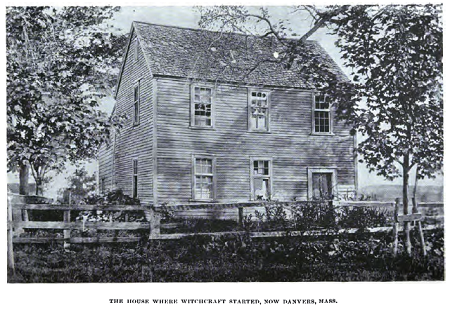
“The House Where Witchcraft Started,” photo of the Salem Village Parsonage, home of Samuel Parris, Danvers, Mass, published in Witchcraft Illustrated by Henrietta D. Kimball, circa 1892. This house is actually just an addition that was added to the parsonage house in 1734. The original parsonage house was torn down in 1784 and this addition was then moved to Sylvan Street in Danvers.
When Parris began his new position, he quickly found himself in the middle of these same Salem feuds and, according to the book The New England Soul, he didn’t handle it well:
“Parris had not enjoyed a moment’s peace since the commencement of his ministry in 1689, when he found himself caught between warring factions in Salem Town and Salem Village. Instead of confining and channeling social fears and tensions into revival and covenant renewal as his colleagues were seeking to do, Parris inflamed local rivalries by declaring that ‘if ever there were witches, Men and Women in covenant with the Devil, here are multitudes in New-England.’ By March 1692, he was convinced that witches had infiltrated the churches, including his own Salem congregation. In a sermon on Judas Iscariot he declared that ‘as in our text [John 6:10] there was one [devil] among the 12 [disciples]…so in our churches God knows how many Devils there are.’ Such preaching offered a powerful and dangerous release for social and political tensions that had been brewing throughout the previous decades. It encouraged the villagers to purge their feelings of frustration and guilt by locating and destroying ‘witches’ in their midst. In many cases these witches were individuals who had run afoul of Parris and his key clan of supporters, the Putnam family.”
Samuel Parris & the Salem Witch Trials:
Many historians agree that Samuel Parris played a pivotal role in the Salem Witch Trials and some even consider him one of the main causes of the trials, according to the book The Account of the Life of Samuel Parris:
“We have been thus particular in relation to the settlement of Mr. Parris at Salem Village, it being one of the causes, which led to the most bitter parochial quarrel, that ever existed in New-England, and in the opinion of some persons, was the chief or primary cause of that world-wide famous delusion, the Salem Witchcraft.”
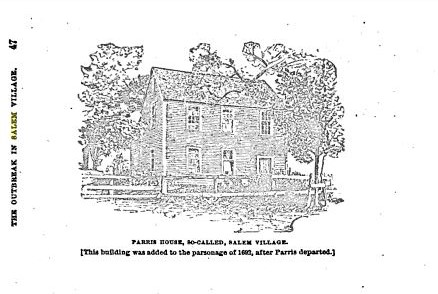
“Parris House, So Called, Salem Village,” illustration published in Witchcraft in Salem Village in 1692; Winfield S. Nevins; circa 1916
The Salem Witch Trials began in Salem Village the winter of 1692 when the afflicted girls, which included Parris’s daughter, Betty Parris, and his niece Abigail Williams, began displaying strange behavior such as suffering fits, complaining of being pinched by invisible forces and etc.
A local doctor was called and when he couldn’t determine the cause of the fits, he declared they were bewitched, according to Samuel Page Fowler in his book Account of the Life and Character of Rev. Samuel Parris of Salem Village:
“Mr. Parris appears to have been much astonished, when the physicians informed him, that his daughter and niece were, no doubt, under an evil hand. There is evidence that Mr. Parris endeavored to keep the opinion of the physicians a secret, at least, till he could determine what course to pursue. At this time, Mary Sibley, a member of his church, gave directions to John Indian how to find out, who bewitched Betsy Parris and Nabby Williams. This was done without the knowledge of Parris. The means used to make the discovery, was to make a cake of rye meal, with the urine of the children, and bake it in the ashes, and give it to a dog to eat. Similar disgusting practices appear to have been used to discover and kill witches, during the whole period of the delusion.”
A few days after the witch cake incident, the girls named three women they believed were bewitching them: Sarah Good, Sarah Osbourne and Tituba.
After Tituba was arrested on March 1, she made a shocking confession that she was indeed a witch and warned that there were other witches in Salem. This confession sparked a mass hysteria and started a massive witch hunt in the colony.
Many historians believe that the Putnam family, particularly Thomas Putnam, took advantage of this mass hysteria by accusing people they disapproved of or wanted revenge against. One theory suggest Thomas Putnam solicited the help of Samuel Parris, among many others, in his cause.
Yet, according to Fowler, there is no evidence that Parris was even involved in the accusations:
“It has been said that Parris had a rival in Rev. George Burroughs, who had friends in Salem Village, desirous of his settlement; and that was a sufficient reason why Parris should appear at the courts against him. We have never seen any proof of this rivalship between these clergymen. It is difficult now to ascertain the cause of the arrest of Burroughs who was preaching at Wells, at the time, in his pulpit. The girl who accused him of bewitching her, was Mercy Lewis, who was then living with Thomas Putnam. She formerly lived with Burroughs, when he preached at the Village; and, upon one or more occasions, he whipped her severely. This we suspect was the cause of her crying out against Mr. Burroughs. It has been said that Rebecca Nurse was an object of special hatred to Parris; but this we have failed to discover….We suspect, from an examination of the charges brought against her at the courts, that she had several times severely rebuked the accusing girls for their folly and wickedness, when meeting in their circles. In this way, she probably incurred the displeasure of Ann Putnam and her mother – her principal accusers.”
The only thing Parris seemed to do for certain was suggest during his sermons that witches were present in Salem. On March 27, Parris informed his congregation about the witch cake incident with Tituba and expressed feared that it may have raised the Devil in Salem, according to the church records:
“27. March. Sab. 1692. Sacrament day.
After the common auditory was dismissed, & before the Church’s communion at the Lords Table, the following testimony against the error of our sister Mary Sibley, who had given direction to my Indian man in an, unwarrantable way to find out Witches, was read by the pastor. It is altogether undeniable that our great & Blessed God, for wise & holy ends hath suffered many persons, in several families, of this little village, to be grievously vexed, & tortured in body, & to be deeply tempted, to the endangering of the destruction of their souls; & all these amazing feats (well known to many of us) to be done by witchcraft, & diabolical operations. It is also well known that when these calamities, first began, which was in my own family, the affliction was several weeks before such hellish operations, as witchcraft was suspected. Nay it never broke forth to any considerable light, until Diabolical means was used by the making of a cake by my Indian man, who had his direction from this our sister Mary Sibley : Since which apparitions have been plenty, & exceeding much mischief hath followed. But by this means (it seems) the Devil hath been raised amongst us, & his Rage is vehement & terrible, & when he shall be silenced the Lord only knows. But now that this our sister should be instrumental to such distress, is a great grief to myself, and our godly honoured & reverend neighbours, who have had the knowledge of it. Nevertheless, I do truly hope, & believe, that this our sister doth truly fear the Lord, & am well satisfied from her, that what she did, she did it ignorantly, from what she had heard of this nature from other ignorant, or worse persons. Yet we are in duty bound, to protest against such actions, as being indeed a going to the Devil, for help against Devil, we having no such directions from nature, or Gods word, it must therefore be, & is, accounted by godly protestants, who write or speak of such matters as diabolical, & therefore calls this our sister to deep humiliation for what she has done, & all of us to be watchful against Satans wiles & devices. Therefore, as we in duty, as a Church of Christ are deeply bound, to protest against it, as most directly contrary to the gospel, yet in as much as this our sister did it in ignorance as she professeth, & we believe, we can continue her in our holy Fellowship, upon her serious promise of future better advisedness and caution, & acknowledging that she is indeed sorrowfull for her rashness herein. Brethren, If this be your mind that this iniquity should be thus born witness against, manifest it by your usual signe of lifting up your hands. The brethren voted generally, or universally: None made any exceptions. Sister Sibley, If you are convinced that you herein did sinfully, & are sorry for it: Let us hear it from your own mouth. She did manifest to satisfaction her error & grief for it. Brethren. If herein you have received satisfaction, testify it by lifting up of your hands. A general vote passed: no exception made. Note. 25. March. 1691-2 I discoursed said sister in my study about her grand error abovesaid, & also then read to her what I had written as above to read to the Church, & said sister Sibley assented to the same with tears & sorrowful confessions.”
Parris also gave a sermon that day, which was titled “Christ Knows How Many Devils There Are” that was apparently written because, as Parris states in the sermon: “dreadful witchcraft broke out here a few weeks past.”
Within the first few lines of the sermon Parris quoted John 6:70 when he stated: “Have not I chosen you twelve, one of you is the Devil.”
As he spoke about Judas, hypocrites and wicked angels, Parris repeatedly quoted the line “One of you is a Devil” and suggested that God knew who the Devil was among them. Parris also suggested during the sermon that the devil could be a fellow church-goer when he stated:
“Let none then build their hopes of salvation merely upon this: that they are church members. This you and I may be, and yet devils for all that (Matth: 8:11-12 – “Many shall come from the east and west, and shall sit down, etc. And however we may pass here, a true difference shall be made shortly.)”
Shortly after, Parris invited neighboring ministers to his house to give advice on what they should do about the presence of witches in Salem. The ministers merely advised Parris to “sit still and wait on the Providence of God to see what time might discover.” Two or three more private fasts were held at Parris house as Parris continued to wait and see what would happen. According to Fowler:
“It is evident from the account given by Rev. John Hale, who was an eye witness to many of the transactions at Salem village, and one of the minsters called for consultation, that Mr. Parris proceeded with caution at the commencement of the troubles, and was anxious to seek council and advice. He likewise wished to inform himself on the subject of witchcraft, and for that purpose received as a loan from Dea. Robert Sanderson, of Boston, a copy of Perkins’ works, which treated upon the subject. We are among those who believe Mr. Parris was honest in his belief in witchcraft, and that he was not moved in his affair by personal malice, or the desire to promote the cause of religion in his Parish, as has been supposed by the author of the History of Danvers. We have not as yet, found a particle of evidence, that he entertained ill will against those who were accused and executed.”
John Wesley Hanson, the author of the previously mentioned History of the Town of Danvers, accuses Samuel Parris of being the driving force behind the accusations and suggests Parris could have prevented the witch trials from happening but instead encouraged them:
“The children were commanded to declare who their tormentors were, and Mr. Parris compelled Elizabeth, to an accusation…When Tituba confessed, she implicated Sarah Osborn a demented person, and Sarah Good, Dorothy’s mother, a poor bed-ridden woman, who were immediately also accused by the afflicted girls, and subjected to a rigorous imprisonment. Tituba afterwards declared that Mr. Parris had whipped her until he forced a confession from her!…To exhibit the feelings of the clergy it is recorded that Cotton Mather called Martha Carrier a ‘rampant hag, the Queen of Hell!’ Noyes of Salem said when he saw several hanging on Gallows Hill, – ‘How sad it is to see eight firebrands of Hell hanging there.’ Mr. Parris seems to have been not quite so malignant as these and some others; he seems to have been desirous of using this excitement to promote a religious awakening in his parish…Had Mr. Parris and others, whipped their children for accusing instead of whipping them to oblige them to accuse, this great blot upon human nature might have been prevented.”
In an attempt to cure his daughter, Betty, and prevent her from getting further involved in the witch trials, Parris sent her away from Salem Village to live in the home of Parris’ cousin Stephen Sewall in Salem town. Although Samuel Parris didn’t want his daughter to be involved in the witch trials, he himself was involved.
According to court records, Samuel Parris testified against nine people: Tituba, John Willard, Martha Corey, Susannah Martin, Rebecca Nurse, Martha Carrier, John Proctor, Elizabeth Proctor and Sarah Cloyce. He also served as the court stenographer for the examination of Abigail Hobs, Giles Corey, Mary Warren, Sarah Cloyce, Elizabeth Proctor, Nehemiah Abbot, Jr. and Mary Black at the request of Thomas Danforth.
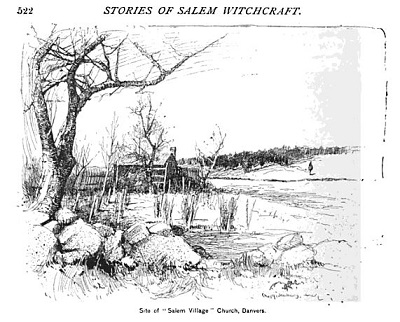
Site of Salem Village Church, Danvers, Mass, illustration published in the New England Magazine, Volume 5, 1892
Yet, in examining the court records, it appears that all of Samuel Parris’ testimonies are merely statements to the court that the afflicted girls appeared afflicted during the numerous examinations.
This is a fact because the girls did behave afflicted during the examinations. Whether they were merely pretending to be afflicted is unknown.
Parris never made any claims himself about seeing spectral visions or suffering fits or any other claim the other witnesses testified about.
According to Fowler, Parris was only present in the court at the request of the court officials:
“Mr. Parris has often been accused of being over officious, and a swift witness against the accused at the courts. Parris could not be said to have been a chief witness in the prosecutions, although he may be said to have been a frequent corroborating witness with his neighbors. The chief witnesses were the accusing girls, as they were called. At the preliminary examinations before the magistrates, Parris and others were required to be present, when the depositions were taken down, as related by the girls, and afterwards made use of at the trials by the courts. These being given in and related by children, and young persons, the Court required an endorsement from some older persons, who witnessed their supposed afflictions, and could attest to their depositions. It is in this way Mr. Parris’ name, as well as his neighbors, frequently appear in the court documents. Parris appears to have been frequently at the examinations of those accused of witchcraft, and put questions to those on trial. He also acted as a recorder to the magistrates more frequently than others. The reason for his being often employed by the courts was simply because he was requested to do so, and was discovered to be well qualified for that purpose. We have seen the records of several persons thus employed, and should say Parris’s was the best. It was his practice to take down the examinations in short hand, – he being a good stenographer, – and then write them out in full, in a plain, legible hand.”
Meanwhile, Parris also oversaw the excommunication of several convicted witches in his church and even delivered the news to the victims themselves. One such victim was Martha Corey, whom Parris visited in prison in September, according to the church record book:
“11. September. Lords day
Sister Martha Corey taken into the Church. 27. April. 1690. was after Examination upon suspicion of Witchcraft. 21. March. 1691-2 committed to Prison for that Fact, & was condemned to the Gallows for the same yesterday : And was this day in Publick by a general consent voted to be excommunicated out of the Church; & Lft. Nathanael Putnam, & the 2 Deacons chosen to signify to her, with the Pastor the mind of the Church herein. Accordingly this 14. Septr. 1692. The 3. aforcsd Brethren went with the Pastor to her in Salem Prison, whom we found very obdurate justifying her self, & condemning all that had done any thing to her just discovery, or condemnation. Whereupon after a little discourse (for her imperiousness would not suffer much) & after Prayer, (which she was willing to decline) the dreadful sentence of Excommunication was pronounced against her.”
Samuel Parris also gave a sermon that day, which he titled “These Shall Make War with the Lamb” during which he stated that there were offending parties trying to make war with God. He defined these offending parties as antichrists and instruments of Satan who instigated the war by “sorceries and witchcrafts (plentiful among the Papacy) doing lying wonders, whereby multitudes were deluded.”
Parris also consoled his congregation by telling them that the war won’t last forever for a number of reasons, one of them being: “Sometimes the devil loseth his volunteers in war. The lawful captive, the captives of the mighty, are sometimes delivered.” He then went on to warn his parish that there were multitudes of witches in New England, including in the church.
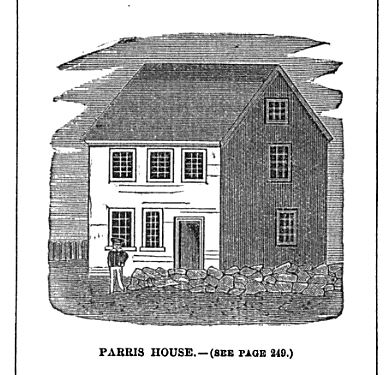
Parris House, illustration published in Old Naumkeag, circa 1877. This appears to actually be an illustration of the parsonage addition built in 1734.
Other sermons Samuel Parris gave that year that have not been documented include a sermon given on May 8, 1692 which was based on the biblical text: 1 Corinthians 10:21: “Yet cannot drink the cup of the lord and the cup of devils,” a sermon on June 19, 1692 based on Canticles 2: 1 “I am the rose of Sharon, and the lily of the valleys” and a sermon on July 13, 1692 based on John 6:48 “I am the bread of life.”
The last hangings of the Salem Witch Trials took place on September 22, 1692. Shortly after, the court banned spectral evidence, which made most of the witchcraft accusations baseless, and the witch trials began to die down. The last of the accused witches were released from prison in May of 1693.
Although Parris’ slave Tituba had confessed and the jury declined to indict her, she remained in jail in Boston because Parris refused to pay her jail fees, which came to about £7.
Some historians think it’s because Parris was angry at her for recanting her confession in prison. Others think he didn’t want her in his home anymore because she should would have been a constant reminder of the witch trials.
Whatever the reason, in April of 1693, Tituba was sold to an unknown person for the price of her jail fees. It is not known what happened to her husband, John, at this point but it is assumed he was sold alongside Tituba because Puritans were reluctant to separate married slaves.
Samuel Parris After the Salem Witch Trials:
Samuel Parris’ life immediately after the Salem Witch Trials is a long, complicated mess of quarrels, lawsuits and counter lawsuits between him and his congregation in Salem.
From the church records, it appears that after the trials ended, the family members of those killed held Parris accountable for the Salem Witch Trials, according to Fowler:
“We have not been able to discover the cause of the alleged complaint of witchcraft, against those three excellent women, viz: Rebecca Nurse, Mary Easty, and Sarah Cloyce. They were sisters, of a good education, and fair reputation. It is not to be denied, that the part Parris took in the trials of these women, was the chief cause of the opposition towards him, and led at last to his dismission from the people at the village. His principal opposers were the relatives of these three unfortunate sisters. Samuel Nurse, a son of Rebecca Nurse, John Tarbell, who had married her daughter, and Peter Cloyce, who had married Sarah Cloyce. These three persons, together with one Thomas Williams, after the execution of Rebecca Nurse and Mary Easty, and the imprisonment of Sarah Cloyce, became much dissatisfied with Parris, and sought advice of the Elders in some of the neighboring churches, as to the best mode of bringing him before a council to answer for his conduct in the Witchcraft delusion.”
These dissenters began protesting Parris by refusing to attend services. Parris filed a complaint against them for being absent from church. On February 16, 1693 at a meeting of the church committee, the dissenters gave a list of reasons for their withdrawal, which states:
♦ they were unable to hear and understand Parris’ sermons over the “disturbing tumults and noise” made in church by the afflicted girls
♦ they feared being accused of witchcraft themselves
♦ Parris gave sermons on the witchcraft trials which they found offensive
♦ Parris held views on witchcraft that conflicted with that of the Orthodox Ministers
♦ Parris held an “easy and strong faith and belief” in the accusations made by the afflicted girls
♦ Parris displayed a lack of charity towards the accused
♦ Parris used “unwarrantable and ungrounded methods” of getting the afflicted girls to name suspected witches
♦ Parris provided testimony against the accused witches
♦ Parris served as a court stenographer during the witch trial examinations
♦ Parris preached unsafe and unChristian-like beliefs
♦ Parris refused to explain his actions and his charge against them for withdrawing from church
This list was signed by John Tarbell, Thomas Wilkins and Samuel Nurse.
After reading the charges against him, Parris wrote and presented a paper titled “Meditations for Peace” which is considered by many to be an acknowledgment of his errors during the trials.
In the paper, Parris admits to giving too much weight to the spectral evidence provided by the afflicted girls and admits that “in that sore hour of distress and darkness” he may have spoken “unadvisedly.” He asked for forgiveness so they could all defeat the devil together.
The paper didn’t seem to help at all and the dissenters continued to try and bring Parris before a church council.
Meanwhile, Parris repeatedly charged the dissenters with being absent from church and accused them with other “sundry objections” such as speaking and publishing libelous information against him and the church, harassing him in church and at his home, refusing to contribute to his salary, urging other parishioners to join their cause and etc.
After Parris read these objections aloud in church on November 13, 1693, the dissenters merely scoffed and continued their cause.
After two years of quarreling, the church finally called a council on the matter at Salem Village on April 3, 1695. After hearing the case, the council, moderated by Increase Mather, merely recommended the dissenters to “consider whether, if they continue to devour one another, it will not be bitterness in the latter end.”
The dissenters weren’t satisfied with this response and instead signed another petition asking the council to rehear the case and move Parris to another church.
Although Parris had his share of opposition in the church, the majority of his parishioners at the time actually wanted him to stay. The dissenters made this difficult for Parris though by persuading many parishioners not to pay their voluntary contributions to the church, which is what funded Parris’ salary. From the year 1694 until 1697, Parris only received a partial salary due to the quarrel.
On July 14, 1696, Parris suffered another blow when his wife died. She was buried in the Wadsworth Burial Ground in Salem Village.
A few months later, in October of 1696, it appears that Parris was finally dismissed from the parish because there are no more entries written in his handwriting in the church record book after this date.
Although Parris had already been dismissed, on July 21, 1697, John Tarbell, Samuel Nurse, Joseph Putnam, Daniel Andrew renewed their charges against Parris, claiming he “did swear positively against the lives of such as he could not have any knowledge but they might be innocent” and that he worked with the afflicted girls “to know who afflicted the people in their illnesses.”
According to the book Salem Witch Trials: A Reference Guide the reason for the renewed charges is because the congregation was suing Parris for occupying the parsonage nine months after his dismissal. Parris responded by counter suing for his unpaid salary. The congregation lost their suit and, in 1697, paid Parris a settlement of £79 in back salary.
After Parris’ dismissal from Salem Village he moved to Concord, Mass where he lived until 1705 and then moved to Dunstable where he preached for six months in 1711. Parris then moved to Sudbury, Mass where his daughter, Betty, lived until adulthood. Samuel Parris died in Sudbury on February 27, 1720.
Parris later made an appearance as a character in Arthur Miller’s 1953 play The Crucible. In the play he is portrayed as a power-hungry minister who is determined to build up his position in the community but is disliked by many of the Salem residents.
The site of the Salem Village Parsonage was excavated in 1970 and is open to visitors.
Rev. Samuel Parris Historical Sites:
Salem Village Parsonage Archaeological Site
Address: Rear 67 Centre Street, Danvers, Ma (site is accessible via a cart path)
Former site of the Salem Village Meetinghouse
Address: Near corner of Hobart and Forest Street, Danvers, Mass. Historical marker on site.
Sources:
Hanson, John Wesley. History of the Town of Danvers, from its early settlement to the year 1848. John Wesley Hanson, 1848.
Stout, Harry S. The New England Soul: Preaching and Religious Culture in Colonial New England. Oxford University Press, 2011.
Salem-Village Witchcraft: A Documentary Record of Local Conflict in Colonial New England. Edited by Paul S. Boyer & Stephen Nissenabum. Northeastern University Press, 1993.
MacBean, Jenny. The Salem Witch Trials: A Primary Source History of the Witchcraft Trials in Salem, Massachusetts. Rosen Publishing Group, Inc, 2003.
Fowler, Samuel Page. An Account of the Life, Character, &c., of the Rev. Samuel Parris, of Salem Village. William Ives and George W. Pease, 1857.
Goss, K. David. The Salem Witch Trials: A Reference Guide. Greenwood Press, 2007.
Starbuck, Anward. Cotton Mather’s Relation to Salem Witchcraft. University of Chicago, 1922.

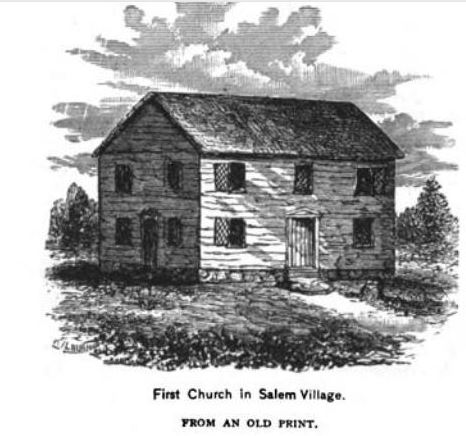
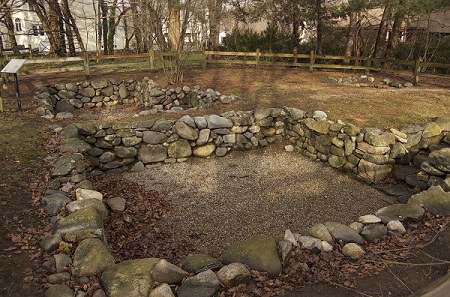
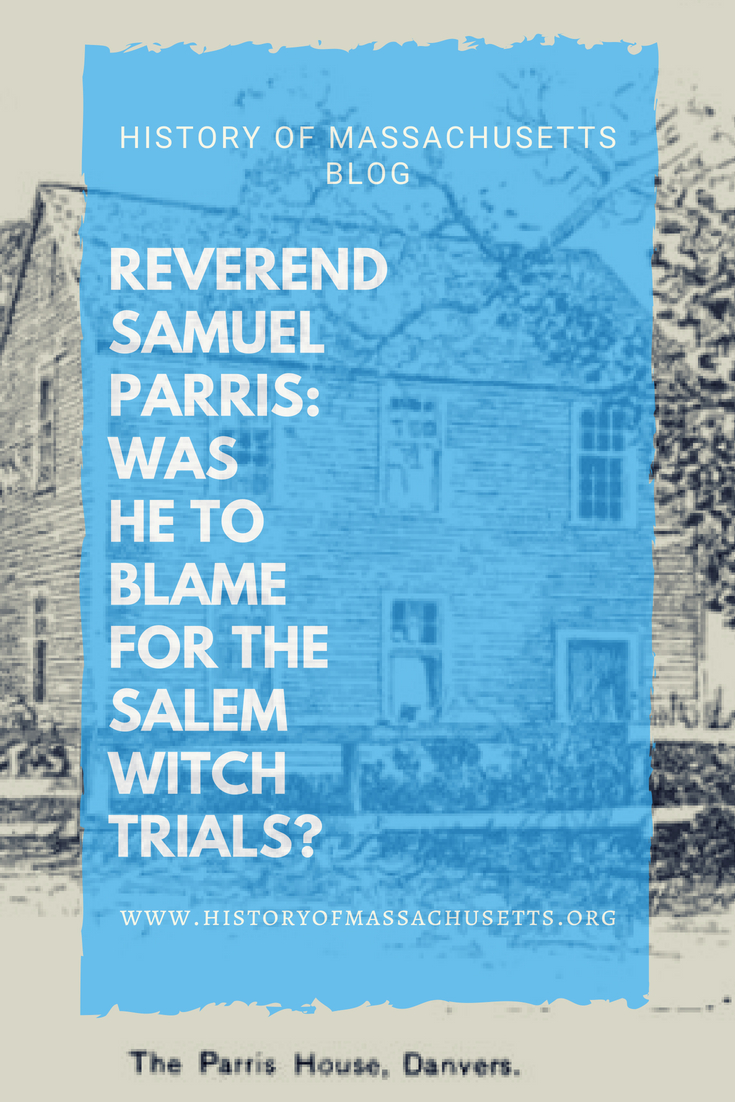
Do you know where rev. Parris is buried
I actually don’t. I tried to find out but I couldn’t confirm anything.
According to the Frances Hill (Salem Witch Trials Reader), he is buried in Sudbury MA.
He is in North Cemetry, Wayland, MA which is close to where he died (Sudbury, MA)
Are you familiar with the Salem Witch Trials Reader, by Frances Hill? She takes a very negative view of Parris as a leader in “witch hunting” and believes he was what we would call today sociopathic in his lack of empathy and conscience.
Samuel Parris is my 10th Great Grandfather, I would like to visit is burial site sometime. I hope this is his accurate burial site, the family is having a hard time finding it.
I am visiting North Cemetery in Wayland this week and will post a link to photos of all Parris family graves that I find. I am researching a book focusing on Abigail WiLLiams. I would be very interested in any family history you might have! I can be reached at dmeyer@gargoylesandmoonvixtnns.com
Samuel Parris is my 9th Great Grandfather. I too would love to visit the burial sites. Did anyone ever post pictures?
Amazing history to read. i have been to Salem on a day trip out of Boston, seeing these places. On another note, an ancestor of mine, Reverend John Edes of Lawford, Essex was one of the witnesses to the court for Rebecca West in 1645, during the times of the Witch Trials in Manningtree. One of his descendants, Benjamin Edes, was the Boston printer of the Boston Gazette and Country Journal, that seditious newspaper that spurred the populace to rebel the British imposition of further taxes and later the Boston Tea Party, he one of the Sons of Liberty and one of the Loyal Caucus of Nine.
Samuel Parris was the (none too popular) interim minister in my native town of Stow, Massachusetts, before — and, I believe, after — the Salem debacle; and the first occupant of Stow’s oldest existing house, the 1685 “Minister’s Manse” near the town’s Lower Common. That house has long been owned by close friends of my family, and I’ve spent many hours there; carved into a wall plank of its original living room is an archaic-script capital “P”… a memento of the Parris family’s residency? We’ve always wondered.
The Stow Historical Society and/or the Randall Library would be able to furnish copies, I suspect, of the old documents that testify to Samuel Parris’s presence in the town. I’ve seen these, but it’s been decades. In a “previous lifetime” as an actor, I played Rev. Nicholas Noyes of Salem Towne (not Salem Village — now Danvers — which was Parris’s turf) in the PBS witch-trial re-creation, “Three Sovereigns for Sarah” — that’s Sarah Cloyce — and that’s the last time I investigated the Stow-Salem connection.
It has long been claimed that Parris is buried in Stow, in the small cemetery near the Lower Common, but I never found the grave. I’ve seen the Wayland grave mentioned above, but I _think_ that one may be the grave of Parris’s son; it would be worth researching. If I still lived anywhere near Massachusetts (we’re in Minnesota), I’d dig into it; I have deep genealogical ties to Salem as well as close personal ties to Stow, where I grew up and where I spent most of my first 40 years, and the connection between the two towns has long intrigued me.
If Parris is in that cemetery, then that little graveyard has a significance all out of proportion to its size: it has also been more or less proven (thanks to the reopening of a grave by town officials back in the 1930s, I believe, in an attempt to substantiate or undermine a long tradition) that it is also the last resting place of the regicide William Goffe, who fled England with two colleagues at the time of the restoration of Charles II to the English throne. The grave was and is unmarked, but the skeleton was found to be missing its skull and its ring finger… precisely the items that would have been needed by someone wishing to return to London with proof of Goffe’s demise, and to apply for the bounty that was on his head. (Again, the Stow Historical Society should be able to provide some detail.)